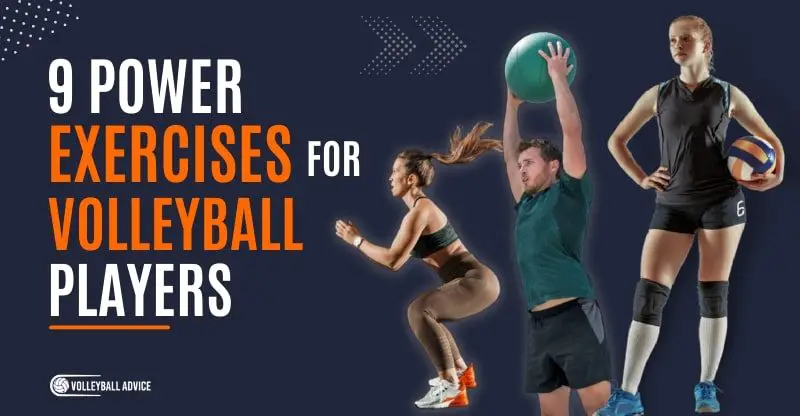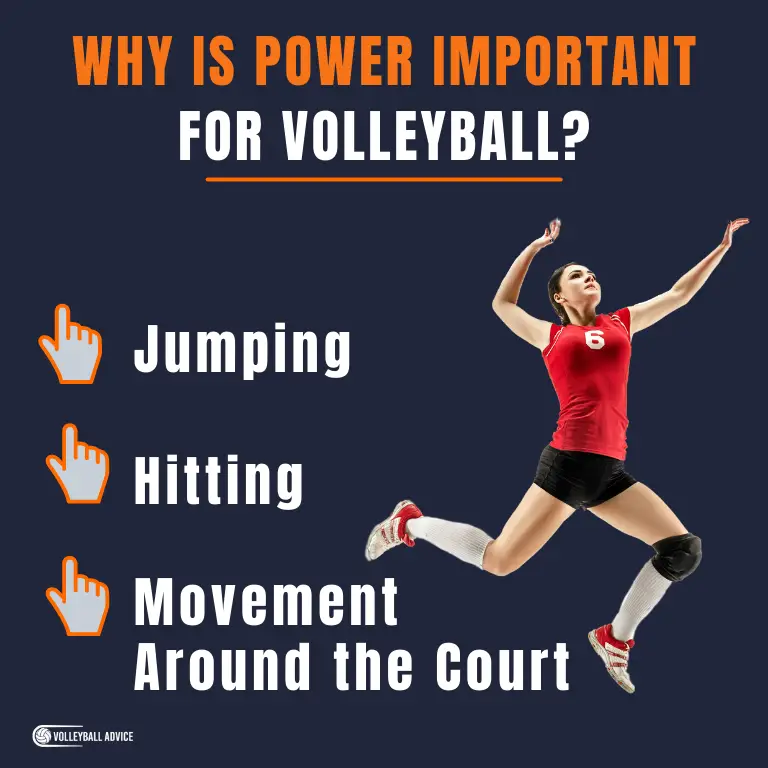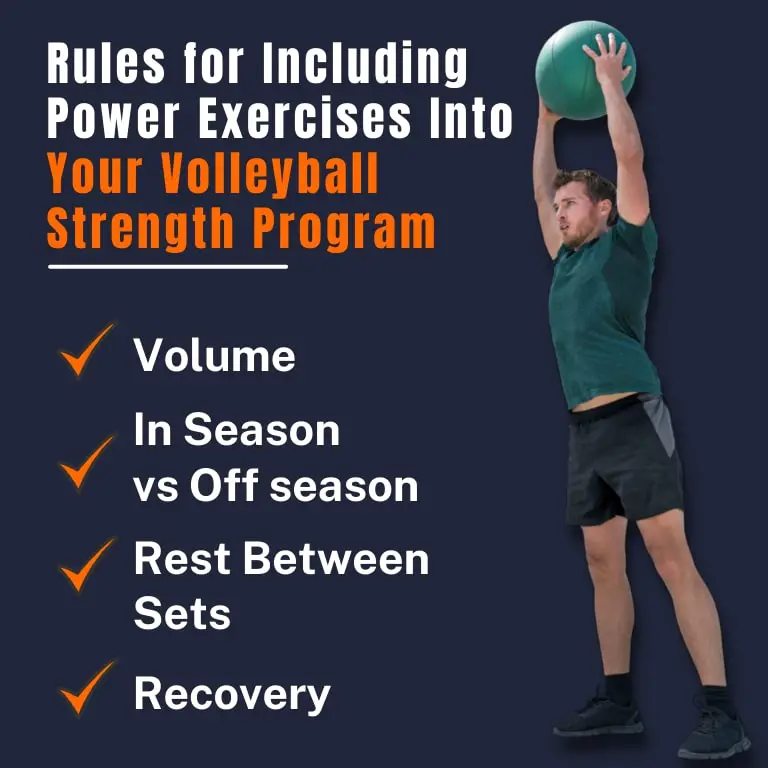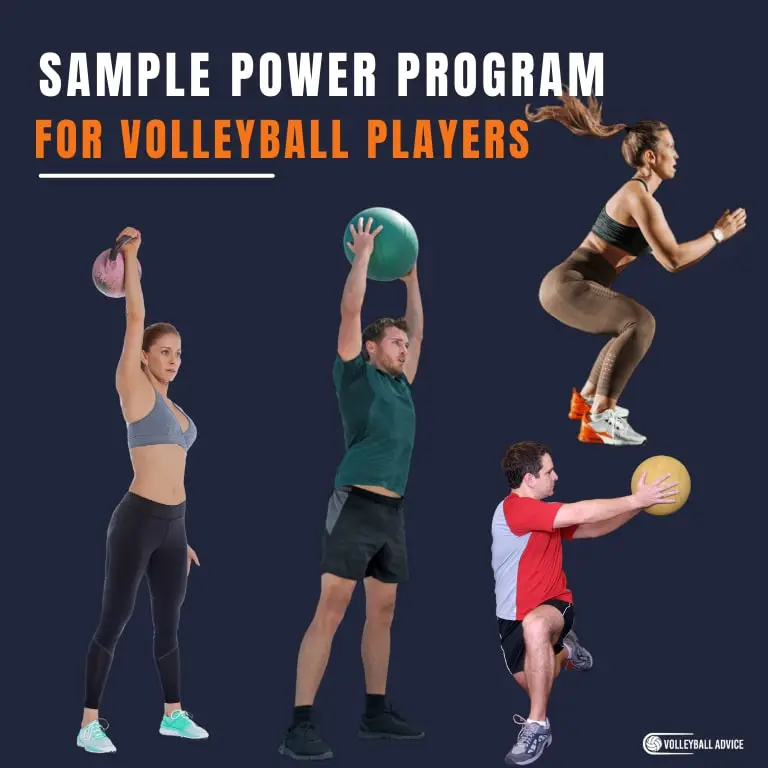9 Power Exercises For Volleyball Players (Sample Program)
If you are looking to train for volleyball it is important to do power exercises as a part of your training and pick ones that Cialis transfer to your sport.
The 9 best power exercises for volleyball players are:
- Landing Mechanics
- ½ Kneeling Med Ball Chop Toss
- Overhead Med Ball Slam
- Counter Movement Jumps
- Overhead Medicine Ball Toss
- ½ Kneeling Med Ball Single Arm Press
- Single Arm Snatch
- Lateral Bounds
- Trap Bar Jumping Squats
Below I’ll cover each of these exercises in detail and provide guidance to help you integrate them into your volleyball strength and conditioning workouts.
Why Is Power Important for Volleyball?
In sports, the terms power and explosiveness are often used to describe moving or projecting something with speed.
Power is important for volleyball for 3 main reasons: jumping, hitting and movement around the court.
The height a player can jump is partially determined by technique and coordinating the contraction of muscles through the body. Once technique is refined the other limit on how high someone can jump is how much power they can produce primarily in the lower body.
Hitting relies on creating power primarily through the torso and upper body. Again coordination aids in this as force is generated through the body whipping the arm. As coordination is improved and muscles developed someone will be able to create faster arm speeds.
A volleyball game is short bursts of quick movements followed by periods of rest between plays.
So in addition to the skills of having power for hitting and jumping, the rhythms of the sports encourage volleyball players to be trained for power and movement around the court.
What Makes A Power Exercise?
Power exercises, like strength excercises, are about producing force and overcoming resistance. The difference is that power exercises also focus on the ability to overcome that resistance in the shortest amount of time possible.
To create this high velocity of movement, power exercises are usually done with body weight or low loads.
Do Power Exercises Help With Volleyball?
Yes, power exercises help with volleyball. By doing power exercises someone can improve how fast they can send the singal from their brain to contract their muscles. In turn, this helps players jump, hit, and move quickly around the court.
What Makes A Good Power Exercise For Volleyball Players?
A good power exercise for volleyball players is one that develops or transfers to the skills of the sport.
For jumping, there are many unloaded (bodyweight) and loaded exercises that allow someone to develop lower body power.
- Counter movement jumps, overhead med ball toss, trap bar jumps, and single arm snatch are all examples of this.
For hitting, you need power in rotation (side to side) and trunk flexion (bending forward).
- Exercises that will help with this are the med ball slam, ½ kneeling chop toss, and ½ kneeling single arm chest pass.
While these exercises take care of power for jumping and hitting, lateral movement is also required to move quickly during play.
- Lateral bounds are a way to develop the ability to move quickly from side to side.
A good power exercise is also one that is able to be performed with technique that is safe and effective.
Olympic weightlifting movements, including the clean, jerk, and snatch, are great exercises that develop full body power and explosiveness. However, they are also very technical and can require a lot of coaching.
- As it seems there are other exercises that can create similar effects, most olympic lifts may not be the best power exercises as the time spent developing weightlifting technique, could be developing on court skills.
Because a good exercise needs the technique to be safe and effective, the exercises below are broken into two groups: (1) beginner, and (2) advanced.
Rules For Including Power Exercises Into Your Volleyball Strength Program
Because of the high physical and neural demand of power exercises there are a few things to consider when implementing them in a training plan.
Volume
It is important to be mindful of the volume or reps done (number of throws, jumps, ect) per session and week. Jumping for healthy individuals a light volume session would be 50 ground contacts while 200+ would be considered high volume.
Volume should progressively be increased as someone starts.
In Season vs Off season
When someone is in season it is expected to jump a lot during practice and games. During the off season it is important to maintain or ramp up to the expected volume of ground contacts to prepare for the demands of the upcoming season.
As discussed above a sudden change in the volume increases the chance of injuries.
During the season it is also important to be mindful that practice and games probably fall in the mid to high volume category. Therefore if weight training sessions have a low to mid volume, <100 reps overuse injuries are less likely.
Rest Between Sets
For rest and recovery between sets there are a few things to consider. For very high velocity or unloaded exercises, consider resting similar lengths as in between volleyball plays, (approximately 16s).
There is limited research on optimal recovery times, but the high demands of power exercises on the body, may call for longer rest periods (1-5 min). This is especially true the more load is being moved.
Recovery
Between sessions and pre competition 48-72 hours is a recommended window of time for rest and recovery. This may not be possible in season. However, reducing the volume of reps a session also reduces the recovery time needed.
Related Article: Reaction Time in Volleyball: 4 Specific Drills To Master
9 Best Power Exercises for Volleyball Players
1. Landing Mechanics
This exercise will help in grain habits for good landing technique, reducing the impact your knees could experience and your chance of injury. It is not done with the intention of building power but is an important part of warming up for the power exercises that involve jumping.
How To
- Start on your tip toes and arms overhead
- Drop your hips and arms to pull yourself into a squatting position, like from landing from a jump
- Your final position is very similar to the position you would start a jump from
Pro Tip
A way to know you are landing with good technique is by how much noise you make. The quieter the better.
2. ½ Kneeling Med Ball Chop Toss
The ½ Kneeling chop develops stability in the lower body, needed for moving around the court while learning to produce more power in the upper body. This is a beginner power exercise as it is easy to do with correct technique.
How To
- One knee down, the other foot flat on the floor in front of you
- You may want a cushion or foam pad for under your one knee
- Both knees should be bent at 90 degrees
- Test if you are upright and stacked over the knee by lifting the front foot of the floor briefly.
- Place the front foot back down for balance
- Stay tall as you slash the ball down across you like you are chopping wood
- Spit the air out as you release the ball
Pro Tip
You want enough resistance to challenge your core, but little enough that it does not slow you down how quickly you move. A 2-8lb ball is ideal for this.
3. Med Ball Slam
This is an exercise to build power in the upper body, especially for hitting. It is suitable for people new to power exercises.
How To
- Stand feet shoulder width apart with a med ball in your hands and overhead
- Throw the ball down as hard as you can, like you were spiking the ball
Pro Tip
Be aware of the combination of ball and floor you are throwing onto, so that you do not damage the floor or have the ball rebound back into your face.
4. Counter Movement Jumps
This exercise is a great opportunity to work on jump technique while also developing the stretch shortening cycle, a key part of helping you jump higher. As it is relatively safe to perform it would be a good power exercise for people newer to training as well as those who are advanced.
How To
- Stand with your feet shoulder width apart and arms raised above your head
- Drive your arms down pulling yourself into a quarter squat
- Immediately explode up by driving your feet into the floor and getting as tall as you can
- Land the jump quietly using the technique learned in the landing mechanics exercise
- Immediately explode off the floor again
Pro Tip
It may be a helpful to place a mini band around the knees as a reminder to use the glutes and keep the knees from collapsing in
5. Overhead Med Ball Toss
This is a beginner exercise as there are less technical and safety considerations than some other loaded power exercises. The overhead med ball toss will help you develop explosive power in your legs and improve your ability to jump.
How To
- Stand tall with a medicine ball in your hands and arms like ropes
- Explode away from the floor tossing the ball as high as you can
- Land quietly like a ninja landing from a tree.
Pro Tip
Toss the ball slightly behind you so you do not have to worry about it landing on you.
6. ½ Kneeling Single Arm Med Ball Toss
While most med ball exercises are relatively simple this one has been considered advanced as it requires resisting motion in the lower body while explosively rotating in the upper body
How To
- Kneeling down on 1 knee. If needed place a pad under the knee, to help with comfort and to level the hips
- Lift your front foot off the ground briefly to align yourself over the back knee. The front foot is just for balance, you want to be tall and stable loaded through back knee
- Hold a medicine ball in both hands with your elbows up
- Rotate so one shoulder points at the wall, one behind you
- Rotate your shoulders and push the ball like you are trying to throw it through a wall
- If your hip bones are headlights, they should shine straight forward as you stay tall
Pro Tip
You will want a light medicine ball 2-10lbs.
7. Single Arm Snatch
The single arm snatch builds reflexive stability in the upper body while also improving coordination for jumping. This is an advanced power exercise as it requires coordinating a jump and catching a load.
How To
- Start in a quarter squat position
- Hold a weight in on arm
- Push the ground away and get as tall as you can from you toes, through your ears
- Drive your elbow as high as you can so the weight comes towards your chin
- Pull yourself under the weight, extending your arm to catch it above your head
- Lower the weight to your shoulder and then back to the start position
Pro Tip
Using a dumbbell is easier for learning technique than a kettlebell. Using a kettlebell will challenge your shoulder stabilizers more.
8. Lateral Bounds
This is a more advanced power exercise as it requires coordination of jumping off one leg and landing on the opposite leg only. But will help with moving side to side on the court.
How To
- Stand on one leg and drop into a quarter squat or athletic position
- Jump to the side and land on the other leg
- Then, jump back to the first leg
Pro Tip
Start by sticking the landing and making sure you are in control of each jump. The next progression is to add a mini hop before jumping back. The last progression is to jump back and forth adding more height and distance to the jumps.
9. Trap Bar Jumping Squats
This would be an advanced power exercise as it requires jumping holding load. If done correctly, it can lead to improvements in jumping similar to olympic lifting, but requires less technical learning.
How To
- Load a trap bar with no more than 20% of your max trap bar squat
- Hold the handles and perform a jump for a squatting position
- Land as quietly as possible and repeat the jump for the number of reps suggested.
Pro Tip
Let the weight come down to the floor between reps. This will unload the spine and reduce the load you need to bring to stop and change of direction.
Sample Power Program for Volleyball Players
Warming up is an important part of any pre workout routine. However with power exercises, the speed that someone intends to move makes it a crucial part of reducing chances of injury and maximizing the exercises.
Prior to doing power exercises it is important to warm up body temperature through movement, the cardiovascular system, increasing heart rate and nervous system, through balance and coordination exercises.
Beginner Power Workout For Volelyball #1
- Landing Mechanics – 3 sets of 5 reps, 30s
- Countermovement Jumps – 3 sets of 5 reps, 1-2 min
- Overhead Medicine Ball Toss – 3 sets of 5 reps, 1-2 min
- Med Ball Slam – 3 sets of 5 reps, 1-2 min
- ½ Kneeling Med Ball Chop Toss – 3 sets of 5 reps, 1-2 min
Advanced Power Workout For Volleyball #2
- Landing Mechanics – 3 sets of 5 reps, 30s rest
- Lateral Bounds – 3 sets of 5 reps, 1-2 min rest
- Trap Bar Squat – 3 sets of 5 reps, 1-2 min rest
- Single Arm Snatch – 3 sets of 5 reps, 1-2 min rest
- ½ Kneeling Single Arm Chest Pass – 3 sets of 5 reps, 1-2 min
Other Strength & Conditioning Resources
- Best Exercises For Volleyball + Workout Routine
- How To Jump Higher in Volleyball (Science-Backed)
- 13 Best Leg Exercises For Volleyball (Sample Program)
- 5 Best Ab Exercises for Volleyball Players (Sample Workout)
- 11 Exercises To Improve Your Volleyball Spike
- Muscles Used In Volleyball (Broken Down By Skill & Position)
- 5 Shoulder Exercises for Volleyball Players
- 7 Best Arm Workouts For Volleyball Players
- Sprint Workouts For Volleyball (6 Examples)
Final Thoughts
Incorporating power exercises are an essential part of a strength training routine for volleyball. If done correctly they can improve jumping, hitting power and quickness of movement around the court.
By including the exercises above post warm up and pre strength training, someone can develop these key muscle and neural adaptations needed for power in ways that transfer to volleyball.
About The Author
Ian started his strength and conditioning career working with elite youth volleyball athletes. Before coaching, he completed a BSc in Biomechanics at the University of Calgary. He has over a decade of experience working as a kinesiologist and strength and conditioning coach, with teens to octogenarians in positions with community gyms to elite sport. Outside of coaching, you can find Ian learning new sports, skiing, river surfing, hiking, and traveling. If you have questions or are interested in opportunities to work with Ian, connect with him via Instagram, Linkedin, or Website.




